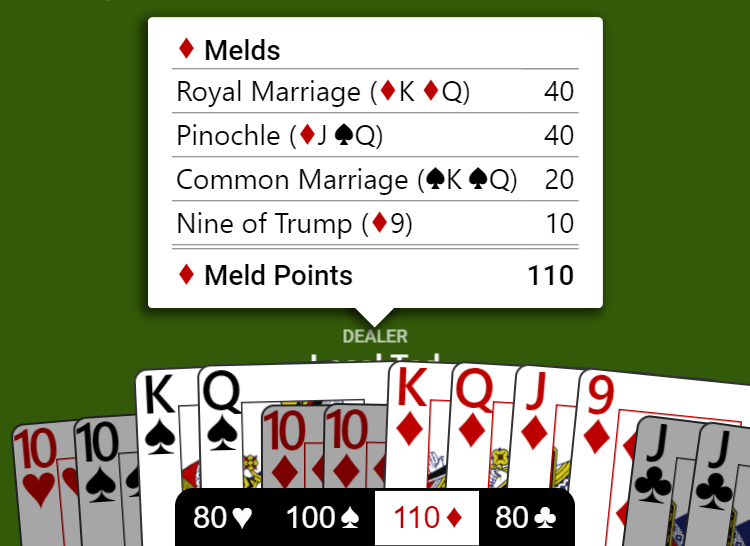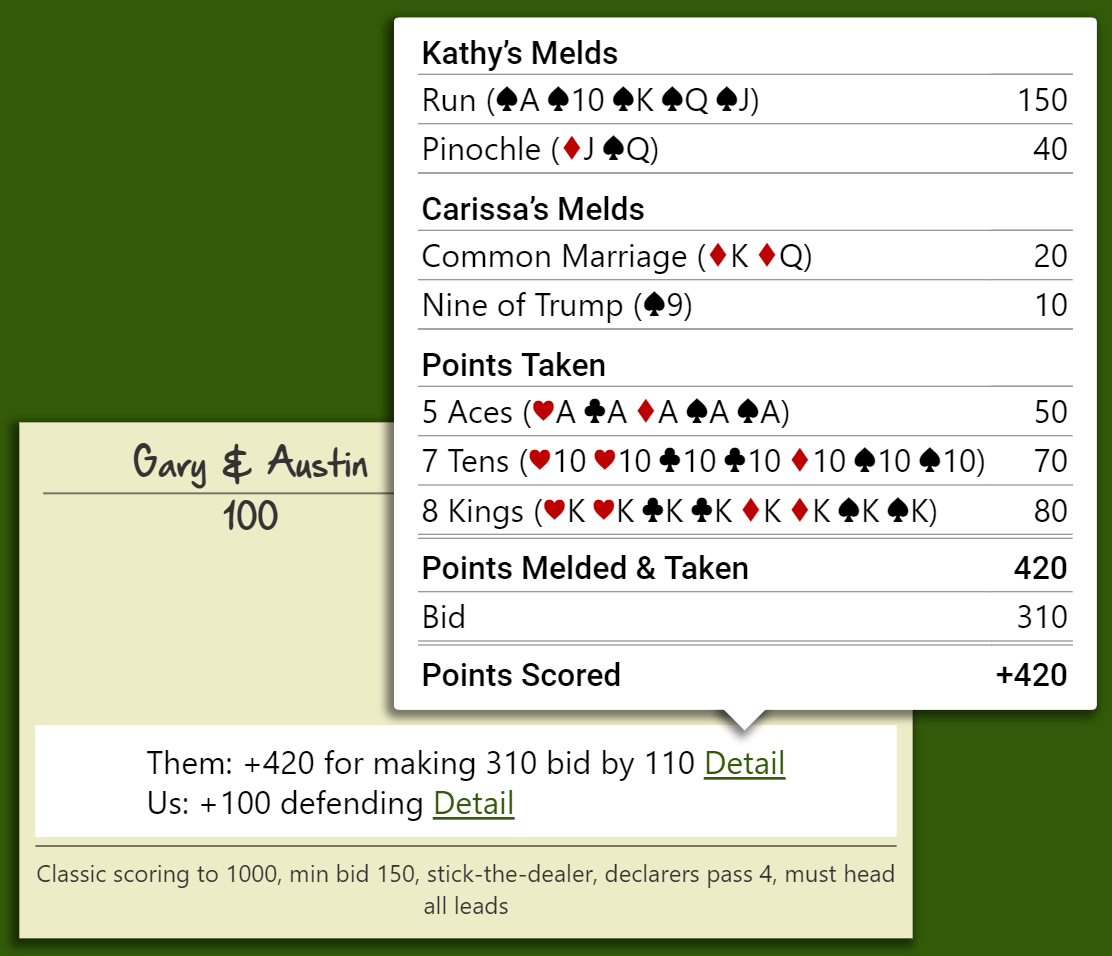Trickster Pinochle is an implementation of single-deck partnership auction pinochle (a game option offers single round bidding). It is a trick taking and melding game where players score points by capturing cards worth points (“counters”) and by forming combinations of cards into meld. The game has three phases: bidding, melding, and trick taking.
Trickster Pinochle offers two scoring styles we call “Classic” and “Modern.” In classic scoring, bids are multiples of 10 and meld such as Aces Around are worth 100 points (often called “100 Aces”). In modern scoring, bids increment by 1 and all the classic meld values are divided by 10. (More on meld values and card point values below.)
Pinochle is played with a 48-card deck consisting of 2 cards per rank of ranks 9 through Ace. The order of ranks from top to bottom are A, 10, K, Q, J, and 9. Note that the 10 is elevated to a position just below the Ace.
Double deck Pinochle uses an 80-card deck consisting of 4 cards per rank of rank 10 through Ace.
When playing without a kitty, all 48 cards are dealt: 12 cards to each of 4 players (or 16 cards to each of 3 players in the 3-player game). In the 4-player double deck game, 20 cards are dealt to each player.
Trickster Pinochle offers an option to play with a kitty (single deck only). If playing with this option, 11 cards are dealt to each player and 4 cards are placed in the kitty (15 cards dealt and a 3-card kitty in the 3-player game). The kitty is added to the high bidder’s hand before he or she declares trump. The high bidder (“declarer”) must discard an equal number of cards before trick taking starts so all players have the same number.
Following the deal, starting with the player left of the dealer, players bid to become the player who declares trump (the “declarer”). Player must bid higher than the previous bidder or Pass. Once a player has passed, he or she is out of the bidding. When all but one player has passed, the remaining high bidder becomes the declarer.
At this point, the declarer chooses the trump suit. If playing with a kitty, the kitty is revealed to all players and then added to the declarer’s hand prior to choosing trump.
As an aid to bidding, Trickster Pinochle displays a meld summary bar over the player’s hand. This bar shows meld points by suit. By clicking on a suit/number pair, we display the meld if that suit was trump.

Meld if diamonds were trump shown by clicking “110♦” in the meld summary bar.
Trickster Pinochle offers an option for the declaring team to pass cards. If playing with this option, following the choice of trump, the declarer’s partner passes 2, 3, or 4 cards to the declarer (the number of cards passed is a game option). The declarer then passes the same number of cards back to their partner.
The purpose of the pass is to improve the declarer’s hand – either their meld or their trick-taking ability.
Passing is not available in the 3-player game.
If the game rule option “Ask to shoot” is on and after the bid is set and players have passed (if enabled), we ask the declarer if they want to Shoot the Moon. If they choose to shoot, they must take all tricks to succeed. When shooting, the declarer’s partner does not play. If they succeed shooting, they are credited with the game over score. This means the game will be over unless their score before shooting was negative. If they fail shooting, the game is immediately over, and the opponents of the shooter win the game.
After the bid is set and the declarers have passed (if enabled), players reveal their meld. Trickster Pinochle does this automatically starting with the declarer and going around the table clockwise.
Meld is not displayed if the declarer chooses to Shoot the Moon.
In double deck, the suit chosen as trump must contain a marriage or better. If not, your team will automatically fail the bid at the first card play. Because of passing, you may choose a suit without a marriage or better but unless you end up with a marriage or better, you will fail the bid.
This rule can be turned off by setting “Marriage+ in trump” to “No” (see Pinochle Rules).
After meld are revealed, trick taking starts with the declarer. Play continues clockwise following the led suit, if possible, or playing another legal card if not. Play continues until all cards have been played.
Note that cards are not all the same point value. Some cards are “counters” and other are not. Depending on the game options, even counters may have different values. This can be important when sloughing cards on a trick being taken by your partner or the other team.
Pinochle has specific rules regarding when a player must “head” a trick, that is, when a player must play a card better than the others already in the trick. Trickster Pinochle offers two popular versions of this rule: “must head trick always” or “must head trick if trump led.” These options result in the following behavior:
This rule requires a player to always beat the winning card in the trick, if possible. If the winning card in the trick is non-trump and the player has higher cards of that suit, they must play a higher card. If they have no cards of the led suit but have trump, they must trump in. If a trump card is currently winning the suit, they must beat that card, if possible.
This rule requires that you to beat the high trump card in the suit only if trump was led. You do not have to beat non-trump cards and you don’t have to beat trump cards played when the led suit was non-trump.
Following trick play, the points of the teams’ meld and taken cards are added. If the declaring team’s points exceeded their bid and they captured at least one counter, they score all their meld and taken points. If they fail to make the bid or capture no counters, the value of their bid is subtracted from their game score.
The defending team is credited with all their meld and taken points regardless.
Trickster Pinochle does all this computation for you and displays the results in a summary on the scorecard. You can view each teams’ score details by clicking on the “Details” link next to their score summary.

An end-of-hand scorecard showing the score details of the declaring team.
The following table shows Trickster Pinochle’s meld and their point values in the two scoring styles.
Name |
Cards |
Classic |
Modern |
Run |
A,10,K,Q,J of trump |
150 |
15 |
Double Run |
2 runs |
1500 |
150 |
Royal Marriage |
K,Q of trump |
40 |
4 |
Nine of Trump |
9 of trump |
10 |
1 |
Aces Around |
1 ace in each suit |
100 |
10 |
Double Aces Around |
2 aces in each suit |
1000 |
100 |
Kings Around |
1 king in each suit |
80 |
8 |
Double Kings Around |
2 kings in each suit |
800 |
80 |
Queens Around |
1 queen in each suit |
60 |
6 |
Double Queens Around |
2 queens in each suit |
600 |
60 |
Jacks Around |
1 jack in each suit |
40 |
4 |
Double Jacks Around |
2 jacks in each suit |
400 |
40 |
Common Marriage |
K,Q of same non-trump suit |
20 |
2 |
Pinochle |
J♦Q♠ |
40 |
4 |
Double Pinochle |
J♦Q♠ J♦Q♠ |
300 |
30 |
Meld may share cards between them except for a Run or Double Run and a Royal Marriage.
Double deck play adds triple and quadruple runs, aces, kings, queens, jacks, and pinochle.
Four additional meld types are available as options (see Pinochle Rules):
Name |
Cards |
Classic |
Modern |
Run with extra King |
A,10,K,K,Q,J of trump |
190 |
19 |
Run with extra Queen |
A,10,K,Q,Q,J of trump |
190 |
19 |
Run with extra Marriage |
A,10,K,K,Q,Q,J of trump |
230 |
23 |
Double Royal Marriage |
K,K,Q,Q of trump |
300 |
30 |
If both options “Double royal marriage” and “Run with extra K/Q/KQ” are enabled, Double Royal Marriage beats Run with extra Marriage because of its higher point value.
Trickster Pinochle supports three ways of scoring counters in the Classic scoring style. We identify these by the cards which count. In the Modern scoring style, only A, 10, and K count and they count 1 point each. The following table shows the point values per card rank for each set of counters.
Rank |
A 10 K |
A 10 K Q |
A 10 K Q J |
Modern |
A |
10 |
10 |
11 |
1 |
10 |
10 |
10 |
10 |
1 |
K |
10 |
5 |
4 |
1 |
Q |
0 |
5 |
3 |
0 |
J |
0 |
0 |
2 |
0 |
Regardless of which cards are counters, there are 30 points per rank. With 8 cards of each rank in the deck, that’s 240 points. An additional 10 points are credited for taking the last trick resulting in 250 capturable points per hand (25 for modern scoring).
If you don’t see your favorite rules listed, use the “More Games/Rules…” button at the bottom of the list of available rules and customize them the way you want. View the available house rule options in Pinochle Rules.